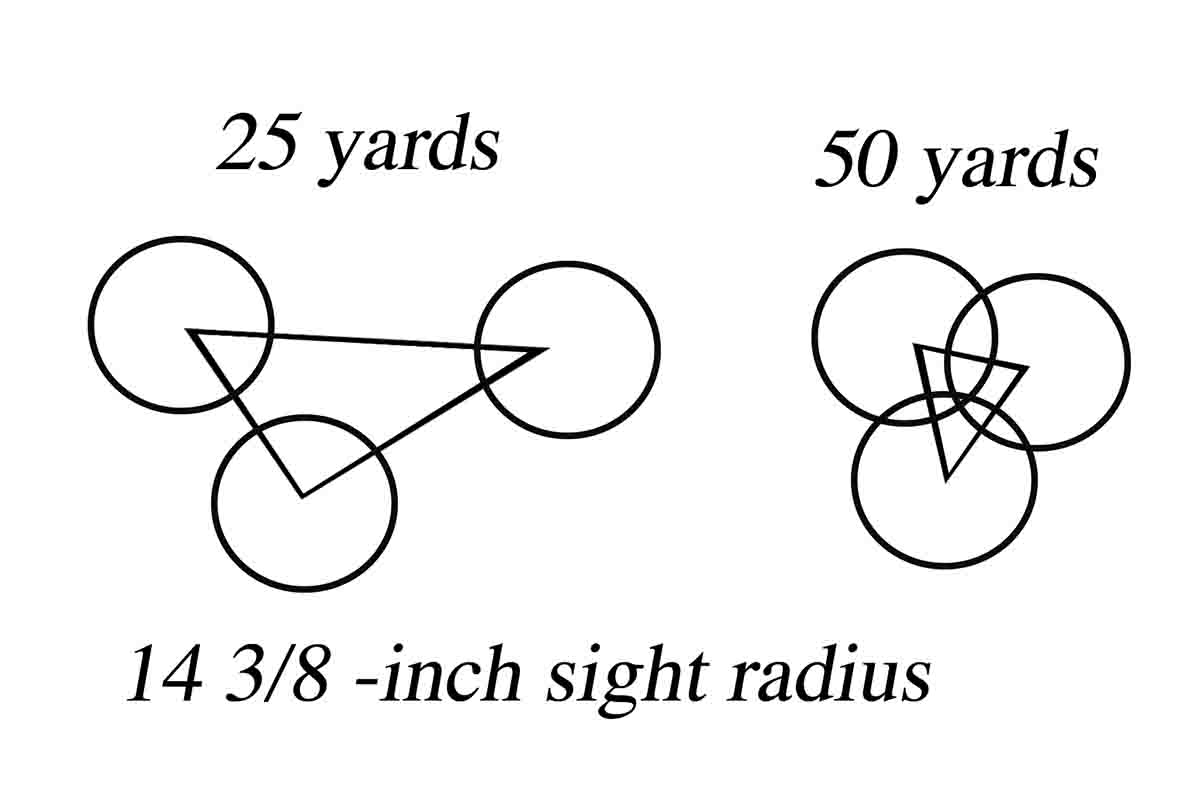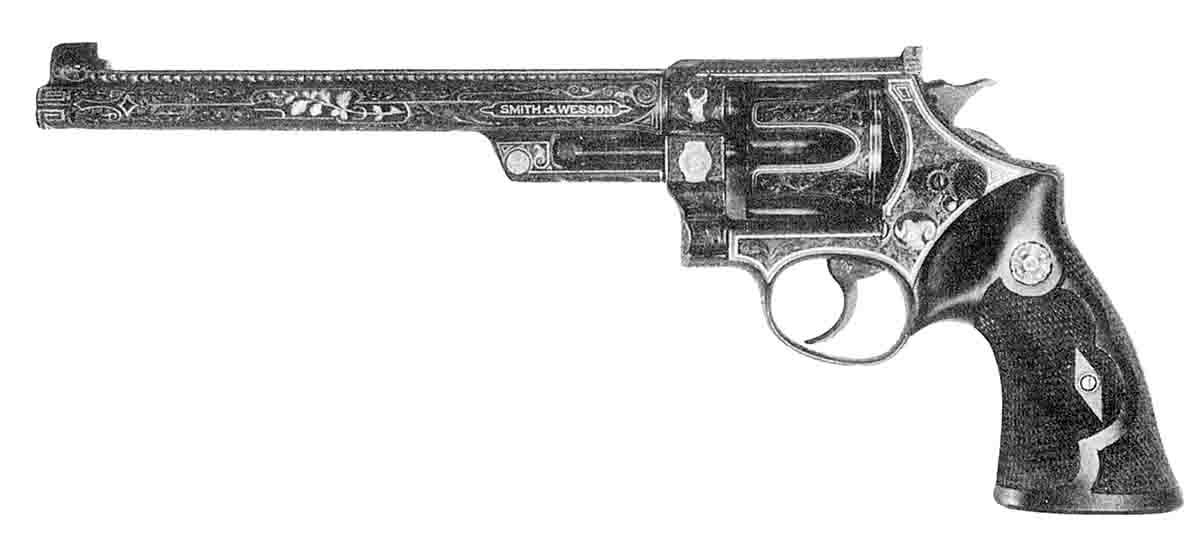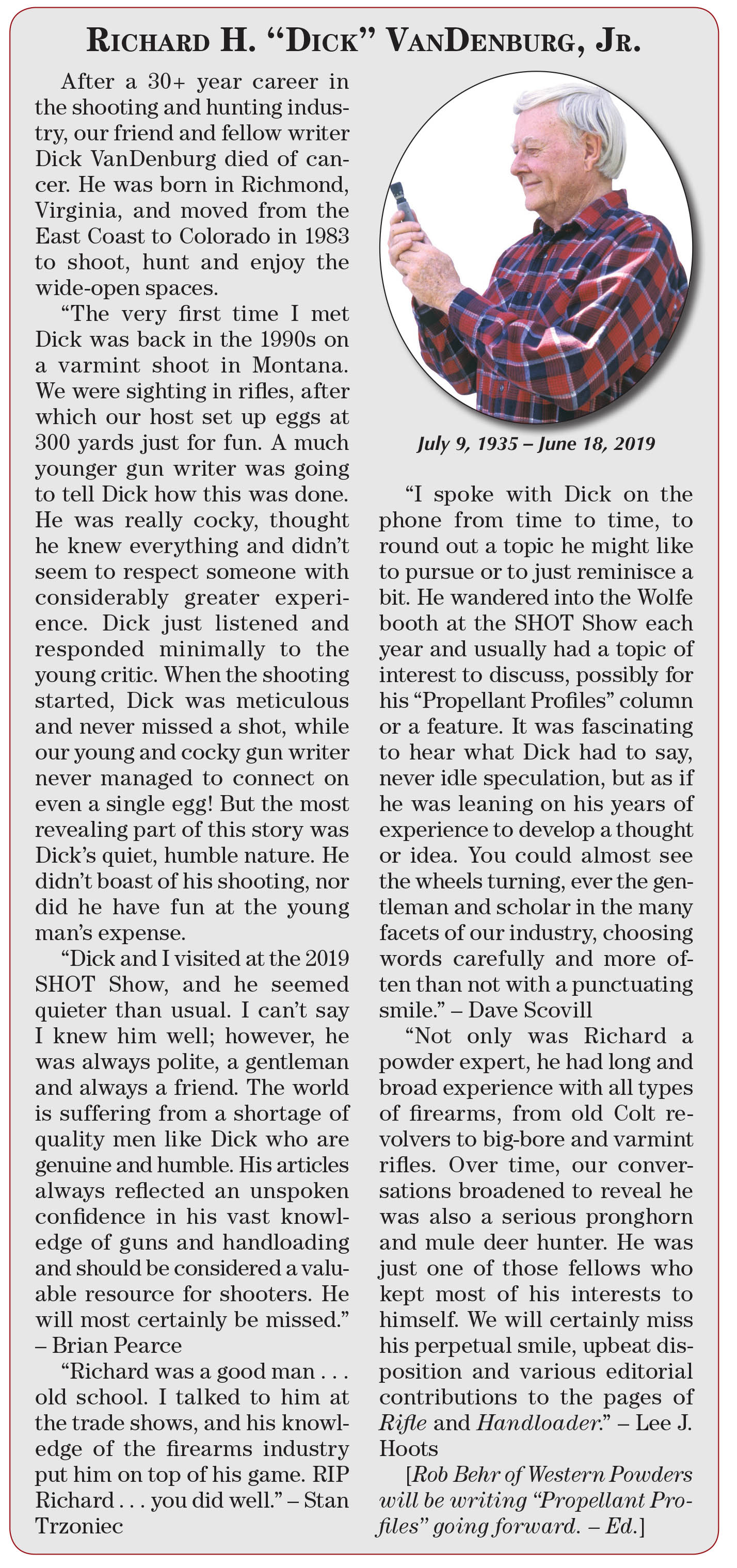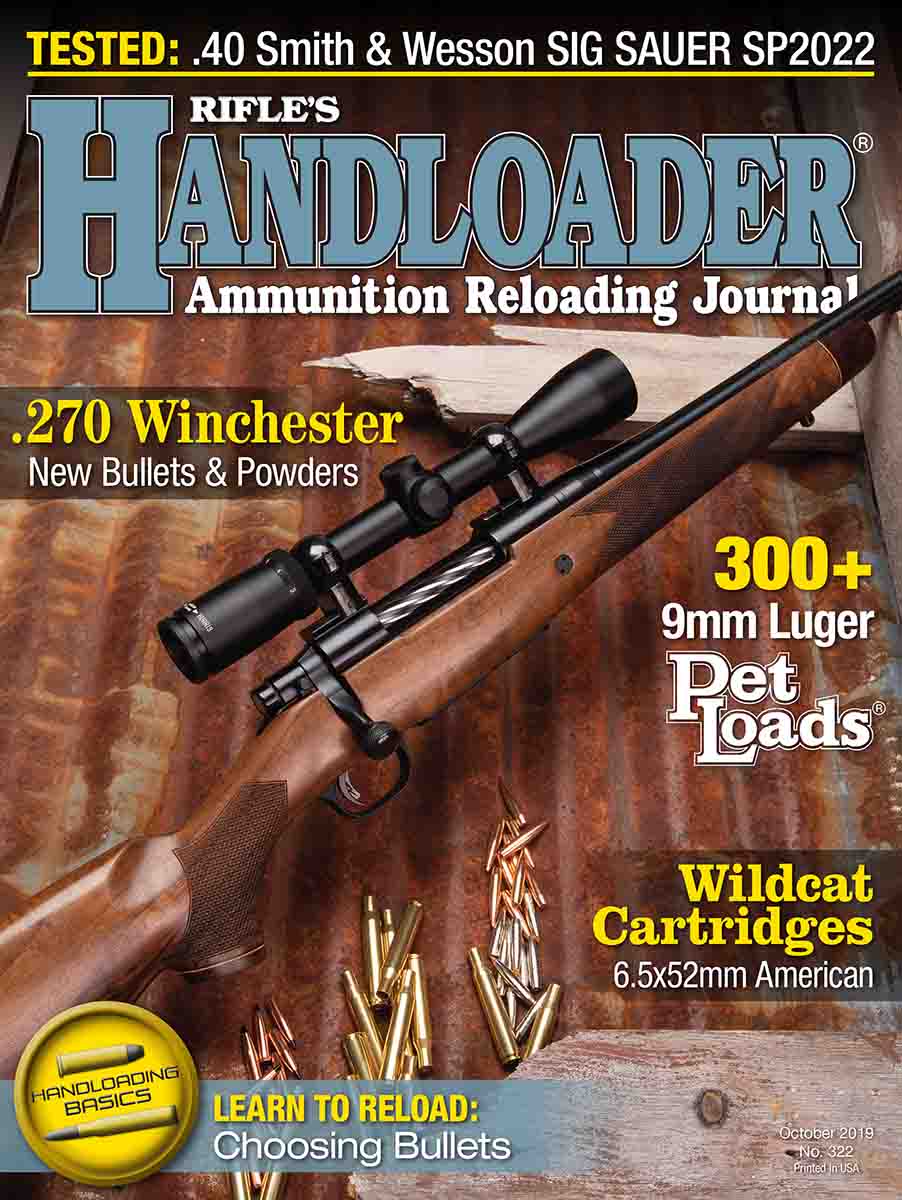Reloader's Press
The Long Shot
column By: Dave Scovill | October, 19
A reader sent a letter regarding a column I wrote sometime ago about shooting a Colt New Frontier .44 S&W with a 7.5-inch barrel at a 12-inch metal plate somewhat beyond 100 yards. The point of the letter was to question the value or purpose of shooting at such ranges where a bullet would presumably lack sufficient power and accuracy to kill a big-game animal. The load in question featured a Rim Rock 245-grain cast semiwadcutter seated over 13.5 grains of 2400 for about 1,100 fps muzzle velocity. The bullet alloy was 1:16 (tin/lead), the same .45-70 arsenal bullet alloy Elmer Keith used regularly in his .44 Special and .44 Magnum loads. The purpose of the test was to determine if the load was capable of shooting as well as previous loads using a similar bullet design, such as the original Lyman-Keith 429421 and/or the RCBS 44-250 KT copy of that bullet seated over the same powder charge.

For the most part, the misses say more about shooting skill than hits. That is, misses are usually the result of subtle errors, relaxing grip tension and/or attention to trigger pull that for me, at least, usually result in a hit low and left of the aiming point. Shots that stray off to “who knows where” are usually chocked up as a mental lapse.

Of course, the fallacy in relegating accuracy standards to groups and/or averages at 50 or 100 yards is that we don’t usually get a chance to shoot groups in animals, large or small. The shot that counts is the first one, so it makes sense to fire one shot at the designated target, put the gun down, or at least wait a few seconds, and start over, where each shot is treated as the first and only shot you have. (The plate should be painted white, so general bullet impact is visible with optics.) Consistent grip and finger placement on the trigger are potential problems for most shooters.
To illustrate how shooters can see the sights differently not only from one shooter to the next, but from one day to the next for any given shooter, Walter Roper, while working for S&W, devised what he called the no-bull target. Specifically, to quote Roper from his book Experiments of a Handgunner, circa 1930s and reprinted by Wolfe Publishing in 1989.
“. . . the gun is fastened so that its position will remain unchanged and so that the sights will be the same distance from the shooter’s eye as when actually shooting. The standard bullseye for the distance is usually mounted on a piece of cardboard and moved over a plain piece of paper by an assistant, as directed by the shooter, until to the shooter, as he looks over the sights, it appears to be exactly centered over the front sight when that sight is centered in the rear notch with its top even with the top of the rear sight. When the target has been brought into this position, a pin is pushed through in the center of the sight bullseye and into the paper behind it. Three such tests give the three corners of a triangle, and the size of this triangle indicates the accuracy of aiming.”
For those who choose to challenge Roper’s methods and conclusion regarding sight alignment, try it with a scope on the handgun to compare with alignment with open sights. The same procedure can be used with open sights compared to a scope on a rifle. Results may show faulty alignment with open sights compared to the scope and/or lousy shooting technique, or both.
Using the sighting triangle (see diagrams), Roper went on to study the effect of different sight radii, which on single-shot pistols was about the same as barrel length, and on revolvers is about 2+ inches longer than barrel length, at 50 yards. His results were compared to other seasoned/experienced shooters who offered their time and assistance in Roper’s experiments. Additional studies included the effect of bright light on one side of the sights, different width sights, at 25 and 50 yards, etc.
Conclusions by Roper and his colleague, Bridgman, suggest for the most part (1) accuracy in sighting is not in proportion to sight radius, (2) sharply undercut sights practically eliminate the effect of light changes, (3) a 1⁄8-inch wide front sight is distinctly better than a 1/10-inch, (4) one can claim no alibi for one’s poor shooting with the .45 (ACP) because of the sights and (5) one had better stick to guns sighted for one’s eyes.
Conclusion: (1) the above includes sight radii from 4+ to 14 inches and at least suggests that a shorter sight radius makes it easier to concentrate vision on the front and have less blurring on the rear sight. This is certainly a factor for older eyes whereas a sixgun with a 4-inch barrel and roughly 6-inch sight radius may be better than a longer sight radius.
Additional remarks by Roper include the effect of trigger pull on accuracy and stock design, the latter of which is his “Roper” design that is typical of modern Smith & Wesson magnum stocks. Also note S&W basically adopted the wide Patridge-type (see 3 above) front sight and rear notch to allow sufficient light on either side to facilitate optical clarity, as opposed to the early thin sights used on S&W and Colt handguns. The width of the rear notch is also a factor here, and modern target sights usually have front sights and a rear notch of the same width, regardless of barrel length. When held at arm’s length the rear sight notch appears wider than the front width and offers sufficient light to form a silhouette of the front sight in the rear notch when aligned at arm’s length. Roper also found that any notch that is shallower than the width of the notch caused blurring and loss of accuracy when aiming. For best accuracy, the rear notch should be as deep as it is wide. In either case, the shooter should test for sufficient lighting for fine accuracy.
For field work, Roper concluded the obvious, i.e., for target shooters it is virtually impossible to see typically dark blue or black sights adequately against the back drop of a black bull. (This is the reason the Wolfe Publishing targets I designed several years ago are blue.) Roper also concluded the front sight should have some color – hence red inserts or color options on front sights and white outlines on rear sights from S&W and others. Most target shooters of Roper’s day used a 6 o’clock hold in the light colored area below the black “bull.” The sights, of course, are set to put the bullet somewhat higher, in the “X” ring, than the point of aim.
It is likely that the most important aspect of Roper’s experiments is that he and his associates were capable of shooting the center out of a regulation target at 50 yards from a standing position with a single-shot .22 Long Rifle pistol with a 7-inch barrel.
Roughly 51 years ago, the U.S. Navy issued me two G.I. Colt .45 ACPs and all the ammunition I could purloin from storage at various naval facilities. The XO (Executive Officer) noted I was the only junior officer on board with firearms experience, civilian and military, whereupon he suggested I might have use for them.
It took what is likely 1,000 plus rounds of G.I. ammunition, lots of cleaning and a few weeks of dedicated practice to become reasonably proficient (minute-of-belt buckle) at maybe 20 steps with one of the Colts. The other was marginal at best. Reading Roper’s book some 35 years or so later, his comment regarding “no alibi” for those issue sights on a weapon designed for last resort combat against one or more two-legged vermin at spitting distance struck a familiar note, although not necessarily as Roper intended. Either way, sight alignment comes first, followed by all that other stuff.
[The bullet in the photo on page 8 in Dave’s Handloader No. 321 column was listed as a 230-grain RNFP when in fact it weighs 250 grains. – Ed.]



